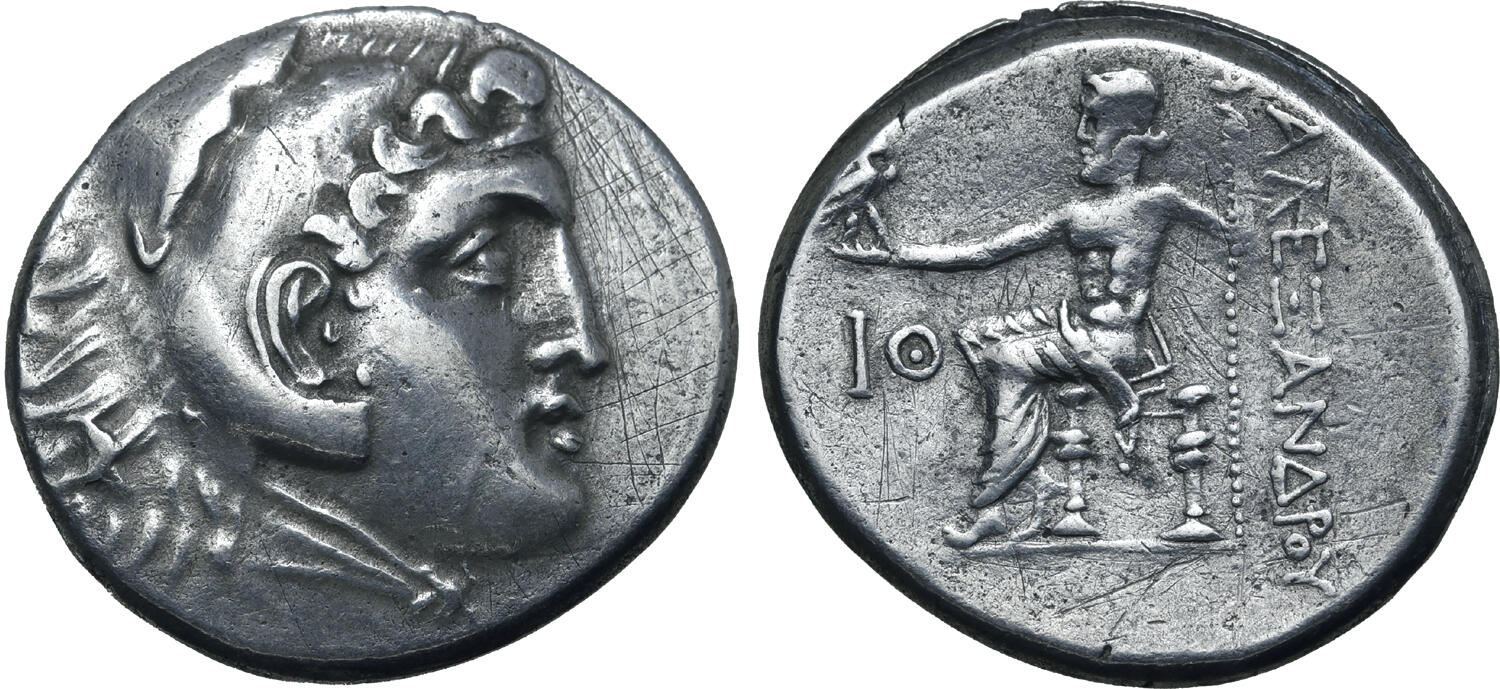S 1841 - Perge (Alexander the Great), silver, tetradrachms (221-188 BCE)
From SILVER
221 BCE - 188 BCE Silver 27,939 kg
Description
| ObverseInscription or printing placed on the obverse.: | Head of Herakles to right, wearing lion skin headdress |
| ReverseInscription or printing placed on the reverse.: | Zeus Aëtophoros seated to left, holding sceptre, AΛEΞANΔPOY to right, IΘ (date) in left field |
Mint and issuing power
| MintIdentifies the place of manufacture or issue of a numismatic object.: | Perge | Ancient regionAncient region.: | Pamphylia | Modern countryModern country: Turkey | AuthorityIdentifies the issuing power. The authority can be "pretended" when the name or the portrait of X is on the coin but he/she was not the issuing power. It can also be "uncertain" when there is no mention of X on the coin but he/she was the issuing power according to the historical sources: | Alexander III the Great (Argead king, 336-323 BC) |
Chronology
| FromIdentifies the initial date in a range assigned in a numismatic context. | 221 BCE | toIdentifies the final date in a range assigned in a numismatic context.. | 188 BCE | PeriodTime period of the numismatic object.: Hellenistic 323-30 BC |
Physical description
| MetalThe physical material (usually metal) from which an object is made.: | Silver |
Median weightMedian of the weights of numismatic objects (in grams). in grams | 16.90 | DenominationTerm indicating the value of a numismatic object. Examples: tetradrachm, chalkous, denarius.: | tetradrachm |
StandardStandard.: | Attic |
Image

S1841 Perge Alexander the Great tetradrachm.jpg [1]
References
| Die study referencePublication of the study: | Colin 19961Colin 1996, p. 17-26 | ||
| Coin series referenceReference to coin series study: | Sear II2Sear II, n° 5412, Price 19913Price 1991, n° 2931 | ||
Obverse dies distribution
| FrequencyFrequency of specimen in distribution. ᵖ | Number of obversesNumber of obverse dies. ᵖ (o) | % (o) | Number of coinsNumber of coins. (n) | % (n) | Die nameName(s) of the die(s). |
| 1 | 18 | 24.32 | 18 | 5.01 | 3.1, 4.1, 7.2, 11.1, 14.2, 14.4, 15.1, 16.7, 20.1, 20.2, 22.3, 22.4, 23.4, 24.3, 25.1, 30.1, 30.2, 31.2 |
| 2 | 11 | 14.86 | 22 | 6.13 | 7.1, 12.1, 14.1, 17.1, 17.3, 20.4, 22.2, 23.2, 28.3, 32.2, 32.3 |
| 3 | 8 | 10.81 | 24 | 6.69 | 1.2, 8.1, 16.2, 16.4, 16.6, 17.2, 20.5, 27.2 |
| 4 | 6 | 8.11 | 24 | 6.69 | 1.1, 16.3, 18.3, 25.3, 28.2, 29.2 |
| 5 | 5 | 6.76 | 25 | 6.96 | 16.5, 19.2, 21.2, 25.4, 31.1 |
| 6 | 5 | 6.76 | 30 | 8.36 | 2.1, 10.1, 22.1, 23.3, 32.1 |
| 7 | 7 | 9.46 | 49 | 13.65 | 9.1, 13.1, 15.2, 16.1, 23.1, 24.2, 26.2 |
| 8 | 1 | 1.35 | 8 | 2.23 | 14.3 |
| 9 | 4 | 5.41 | 36 | 10.03 | 18.2, 19.1, 25.2, 33.1 |
| 10 | 2 | 2.7 | 20 | 5.57 | 13.2, 27.1 |
| 11 | 1 | 1.35 | 11 | 3.06 | 28.1 |
| 12 | 1 | 1.35 | 12 | 3.34 | 24.1 |
| 14 | 2 | 2.7 | 28 | 7.8 | 18.1, 20.3 |
| 15 | 2 | 2.7 | 30 | 8.36 | 21.1, 26.1 |
| 22 | 1 | 1.35 | 22 | 6.13 | 29.1 |
| Total | 74 of 74 | 99.99 | 359 of 359 | 100.01 |
Reverse dies distribution
no distribution is available
Quantification
| Number of obversesNumber of obverse dies. ᵖ (o) | 74 | Number of singletons (o1)The number of singleton coins. ᵖ | 18 |
| Number of reverse diesNumber of reverse dies. (r) | 217 | Number of coinsNumber of coins. (n) | 359 |
| Coins per obverse dieNumber of coins per obverse die. (n/o) | 4.85 | Coins per reverse dieNumber of coins per reverse die. (n/r) | 1.65 |
| Reverse per obverse ratioRatio of obverse dies divided by reverse dies. (r/o) | 2.93 | Percentage of singletons (o1)number of coins (n) divided by the number of singletons (o1) ᵖ | 24.32 % |
| Original number of dies (O) (Carter 1983 formula)The estimation of the number of coins according to Carter 1983 ᵖ | 82.66 | Coins struck if 20,000 as average productivity per dieCoins made if the average productivity for obverses (according to Carter) is 20,000. ᵖ | 1,653,200 |
| Original number of dies (O) (Esty 2011 formula)The estimation of the number of coins according to the singleton formula in Esty 2011 ᵖ (O) | 93.21 | Survival rate if 20,000 as average productivity per dieSurvival rate if average productivity is 20,000. ᵖ | 0.00022 |
| Coverage (o = % of O) (Esty 1984 formula)Esty 1984 - coverage (% of O) ᵖ (o = % of O) | 94.99% | Die productivity if survival rate 1/2,000Average productivity if survival rate is 1/2,000. ᵖ | 8,686.18 |
| Weight of silver (in kg) if 20,000 coins per die (O = Carter formula)Carter 1983 * Median weight * 20000 (*10 if gold or electrum) ᵖ | 27,939 kg <br /> 27,939 kg | Die productivity if survival rate 1/5,000Average productivity if survival rate is 1/5,000. ᵖ | 21,715.46 |
Remarks
Most likely one single workstation